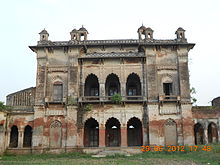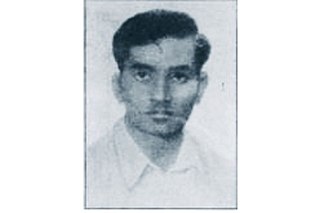History
From 1200 CE, many Rajput groups moved eastwards towards the Eastern Gangetic plains, forming their own chieftaincies. [5] These minor Rajput kingdoms were scattered across the Gangetic plains of modern-day Uttar Pradesh and Bihar. [6] During this process, petty clashes with Native populations occurred and in some cases, alliances were formed. [5] Among these Rajput chieftaincies were the zamindars of Bhojpur [7] and the taluks of Awadh. [8]
The immigration of Rajput clan chiefs into these parts of the Gangetic Plains also contributed to the agricultural appropriation of previously forested areas, especially in Southern Bihar. [9] Some historians have linked this eastwards expansion with the onset of Ghurid invasion in the West. [9]
These groups included the Ujjainiya clan of Parmar Rajputs. [10] Gajpati Ujjainia of the same clan was a chieftain and commander in the army of Sher Shah Suri. [11] In the early 18the century, Kunwar Dhir, a Rajput Zamindar of Bhojpur district rebelled and fought against the Mughal empire. [12]
In the Middle Ages, Rajput migrants to the region of Bihar founded the Gidhaur Raj, Deo Raj, Namudag Raj and Kharagpur Raj. [13] In the same period, the Rajput Gandhavariya clan controlled a significant portion of North Bihar. [14] The Sonbarsa Raj also belonged to this clan. [15] What brought success to these Hindu princelings was the strong clan organisation upon which they rested. [16]
From the 16th century, Rajput soldiers from the eastern regions of Bihar and Awadh were recruited as mercenaries for Rajputs in the west, particularly in the Malwa region. [17] [18] [19] During the Great Uprising of 1857, a section of Rajputs participated under the leadership of Kunwar Singh, who was the main leader of the revolution in Bihar. [20]

In the traditional agrarian society of Bihar in the pre-independence period, Rajputs were among the upper castes that controlled the agricultural production through Zamindari rights. Some of the upper-castes were also recruited to the lower level of administration under the British rulers. Rajputs, a less-literate relative of other upper castes, played a limited role in public administration and were primarily property holders. [21] Between 1900 and 1920, it was noted Rajputs formed a large portion of the population of some regions of southern Bihar.[ clarification needed ] In Shahabad region, where Rajputs were prominent, they took little or no interest in intellectual pursuits. The literacy rate of the region and of Bihar as a whole was also in precarious state. [22] [ clarification needed ]
In post-independence India, pressed with the Zamindari abolition and Bhoodan movement, Rajputs and other upper castes lost their prominence in the agrarian society of Bihar. [23] [24]
This section may lend undue weight to certain ideas, incidents, or controversies. Please help to create a more balanced presentation. Discuss and resolve this issue before removing this message. (June 2022) |
Oliver Mendelsohn and Marika Vicziany said the "untouchables" who formed the bottom of society in Bihar have clashed with communities, including Yadavs and Kurmis in the middle segment, While Rajputs, Bhumihars and Brahmins in the upper segment of society. The authors have identified land control as the major characteristic of the opponents and not the caste identity. According to Mendelsohn and Vicziany, the exploiters of the untouchables doesn't have the same caste identity in all the region, and the conflicts were not restricted to Bihar. [25] The Rajputs and Bhumihars and not the Brahmin and Kayastha being the major landowners among the upper castes is also supported by a study by sociologist Badri Narayan. [26] In Shahabad district, some Rajput and Bhumihar landowners frequently raped lower-caste women, and by 1930s, the Triveni Sangh gave the abused women a platform to express her frustration. [27]
In a survey conducted[ when? ] in a few villages in Bhojpur, rape of lower-caste women from Musahar and Chamar castes by Rajput and Bhumihar landlords was a major cause of anguish until the emergence of Naxalism. [28] [29]
According to Fernando Franco, in parts of central Bihar, who describes the condition of women agricultural laborers; "Even as late as the 1970s, the rape of lower caste women by [some]Rajputs/Bhumihars[landlords] had almost become a tradition, an accepted social evil, a fate which many bore unquestioningly". [30]
Ranabir Samaddar cited an example of an Anwa village in which upper-caste Rajputs practiced Dola Pratha; newly wedded brides of Dalits and landless labourers had to spend one night with the landlord before having sex with her husband. [31] According to a report from Sonatola village in Bihar, in the neighbouring village Berath, some Dalit women said when lower-caste women rejected the landlord's proposal of sexual contact, it was common for the landlords to falsely implicate the male members of their families and their kin in criminal cases. Besides sexual assaults, the drawing of water from the village wells and walking on the pathways alongside the landlords in that village were forbidden for the lower castes. [32] By the 1960s, most of the prevalent feudal practices came to an end due to the activism of Kisan Sabhas, an organization led by middle-peasant castes who also campaigned for women rights and dignity, and allowed agricultural-labourer women to speak for themselves. [32] : 72–73
Later, assertion of many left-wing organizations took place in Bihar, the most prominent among them being Maoist Communist Centre of India (MCC), which waged wars against the landlords for the cause of lower castes. In Bihar, the prime targets of this organisation were Rajputs, against whom most of the caste-inspired massacres were committed. The events at "Darmian" and Dalelchak-Bhagaura, among others, are considered caste-based violence perpetrated against Rajputs by MCC. [33]
In the 1990s, the accession of Lalu Prasad Yadav to the premiership of Bihar brought socio-economic changes in the state's feudal society. Under the leadership of Anand Mohan Singh, a campaign against the Mandal Commission was undertaken in the state. The movement was also opposed to the rule of Lalu Prasad Yadav. Pappu Yadav, an associate of Yadav and a Janta Dal leader, led a campaign of violence against the "Upper Castes". [34]









